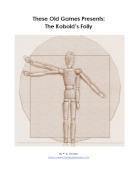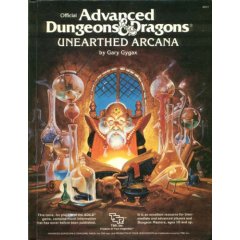I have my new boxed sets of
Old School Essentials. Right now I am sticking to the Basic set and generated several characters. In no particular order, they are 2 Clerics, a Thief, a Dwarf, an Elf, a Magic User, a Fighter, and a Halfling. My intent is to roll as many dice as possible, covering as many scenarios as my players want to do. So, one of every character type in a freeform environment.
I took inspiration from a photo I took in Disney's Epcot. I have this weird mental association between
amusement parks and D&D.
This was taken in the United Kingdom pavilion, I think. This is close to what the characters are experiencing.
The dark circle in the middle of the map is the party's table. Each square is 10 feet. To the north is a willow tree that blocks their line of sight. East and west are a couple of buildings, clearly shop fronts. To the south is a working fountain and what appears to be a damaged church or temple. It is also nighttime here.
The party landed on top of a monster's lair. In the fountain is a group of giant catfish. We'll get to them in a bit.
The party gathers their gear and seeing no immediate trouble, finishes their drinks and meals. They notice their money, chips, and cards are gone from the table. There are several candles, a lantern, and a lamp on the table, just like in an Italian Bistro.
Their first real move is to explore the tree.
Nothing... it's a tree.
On the other side, there is an intersection of roads, three of the roads meet here and curve back to the north. There is also a couple of shops and houses. They decide not to go that way because this is solitary play and I say so.
The characters hang the lantern from the tree limbs on the north side so as to silhouette anyone approaching from that direction. While this is sort of the right idea, it is kind of like saying "Oneth by land" to any wandering monsters. I haven't been rolling for wandering monsters because the party hasn't been loud or there long enough.
They go to the larger building to the west. It's a general store with large windows covering the eastern side. The Thief goes into thief mode and accesses the building. The northeastern door is made of wood and glass and it has a lock. She notes no traps but knows the bell will ring if she forces the door. The southeastern door is barred with a heft piece of wood. They can't see into the back of the building.
Plans are made and they decide picking the lock is best. The whole party works together to get a small sack around the bell to prevent it from ringing.
They quickly explore. There is an apartment upstairs, the backroom is for supplies while the front room is for home goods. It is musty, dry, and smells vaguely of the sea. All foodstuffs have rotted so long ago, they don't smell. There is no money in the till. The party also notes some odd things missing. In the supply room, there are all sorts of tools, but no pickaxes or shovels only rakes and hoes. Upstairs, the family's clothes have been tossed like someone packed in a hurry. Everything else seems normally well-kept.
They return to the fountain. Since the catfish stay in the water, the party doesn't notice them. The fountain smells of the ocean and the fountain's water moves with a heartbeat-like pulse. This attracts the Dwarf's attention. At first, he wants to know how it was done. On inspection (and die rolls), he determines that it used to be a freshwater fountain, but the sea has infiltrated the source waters and the pulsing is from the ocean waves. He notices that the bottom of the fountain has collapsed and is where the sea water comes in. There is nothing to indicate that a group of catfish are down in the deep.
Now for the amusing part of random.
The Thief finds a couple of coins in the fountain and goes to look for more in the water. The rest of the party is disinterested in a few old coins and goes to investigate the shop to the east.
Surprise time.
The Thief and by extension, the Dwarf surprise the catfish. I could totally see this in real life. The catfish don't expect invaders and don't normally investigate stuff. They take time to warm up to prey entering from above.
The Thief finds a few coins and attempts search the waters in the first round of surprise. Just because she has the advantage doesn't mean she is ready for a fight. She is barefooted, holding a lamp in one hand and fishing around with the other. In the next round, the water boils. The catfish launch themselves at the Dwarf and Thief.
 |
| Dice can be dirty. |
I had high hopes for this part. A Catfish springs at the Thief from behind, who is wearing leather armor, and another snaps at the Dwarf in plate armor and partial cover from the wall of the fountain.
I had expected to use THAC0 or ascending AC. In order to calculate either, I need to look in the Adventures book on Page 30, then look at the Character book for character's THAC0 number then go back to pages 26 to 28 in the Adventures book before finding out that I need to look in the Monster book for information on Catfish.
Or... I could look at one table on page 31 and be done with it. There is no difference in any of the methods except extremes are more with the table. This really is a case of never using either rule before and having to access the info. It really is just a matter of remembering stuff so I will try it again next session.
The Dwarf sees that catfish rising to strike the Thief from behind and swings his warhammer at it for 4 points of damage. The Thief is running, not attacking and also takes 4 points damage from a leg bite. Since that is all she has, she goes down narrowly avoiding setting herself and the Dwarf on fire with the shattered oil lamp. The catfish doesn't land any hits with the feelers.
The rest of the party comes running and gets the double dirty from the dice rolls.
Since there is a virtual riot of activity, I roll for a wandering monster. The result is a herd of wild horses. They enter from the east of the map, see the fire and mayhem, then loop around the store and retreat into the dark as the party lofts arrows at them. The Clerics attend to the Thief.
I use a -10 HP as house rule for death, so the Clerics are able to stabilize the Thief with first aid but she is not able to convey any information about the threat. The party decides that the general store is a great place to hold up for the night and retreats.
Since only the Thief and the Dwarf know what actually happened, the rest of the party is mystified by the fire and blood spatter caused by horses.
They forget about the bell on the door and there is another die rolled for wandering monsters. Nothing answers that dinner bell.
They post a watch downstairs and take the Thief upstairs to a bedroom to sleep it off. I have some of my house rules for healing in
Zero to Hero: Uncommon Commoners, if you are interested. They are useful and timely in this case as the Clerics can't cast spells but can perform first aid or use healing skills. I have a priority of healing: aid (1 hp), then doctor or healer's care (a die roll), then rest (as per whatever rules) and finally magical healing. No one can render first aid or skill-based care after magic has been cast, but the reverse is NOT true. It annoys healers to no end when Clerics cast magic first and then drag someone to a healer. It forces a healer to use only magical means. Magic is a consumer product in my world; it has consequences for society.
By sunrise, the Thief comes to with 3 hp. She wants to thank the Dwarf for rescuing her. There is a sheepish look from the party as they realize they didn't do a headcount after their retreat to the general store. In splitting the party between upstairs and down, they had no idea he was missing.
By the fountain, they find a warhammer and a boot. In saving the Theif, a second catfish hit the Dwarf. He had 9 hp and the first bite did 15 points of damage. Then came the 4 feeler attacks. -10 was not enough HP. The second catfish pulled his body into their lair.
I could calculate XP, but the party doesn't even know if they found anything or killed a monster... yet.
I think I'll end it here. Next post, I will talk about the Temple and the Missing Tools from the general store.


































